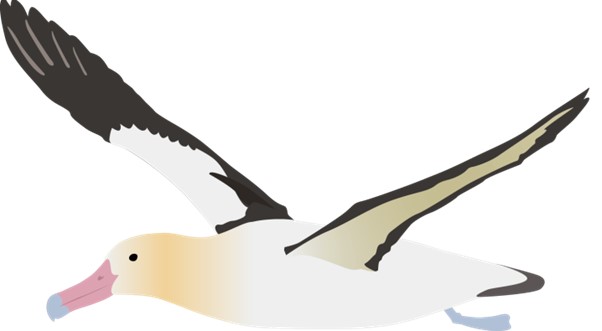
An adult Short-tailed Albatross in flight, from the Yamashina Institute
Japan’s Yamashina Institute for Ornithology is seeking financial assistance via public donations to continue monitoring the breeding populations of Vulnerable Short-tailed Albatrosses Phoebastria albatrus on the islands of Torishima and Mukojima. The Institute writes “It is said that the population of these birds once numbered several million, however they were hunted to near extinction for their feathers. A survey conducted in 1949 stated that the Short-tailed albatross had most likely gone extinct. However, a mere 10 birds were found again in 1951 at the Izu Islands, and their numbers have recovered to around 7900 individuals by 2023, due to focused conservation efforts. We are currently at a stage where the Short-tailed Albatross might be downlisted from the vulnerable to the near threatened category. We are just a couple of steps away from achieving this goal. We need your help and support for this final challenge, as we try to help the Short-tailed Albatross population recover to its past numbers.”

Short-tailed Albatross on Torishima, photograph by Hiroshi Hasegawa
In support of the appeal, Naoki Tomita, Yamashina Institute’s Short-tailed Albatross Project Leader for Torishima writes: “The Short-tailed Albatross resides at the top of the ocean food chain, and is a good representation of the health of the entire global ecosystem. Protecting this species will lead to protecting the environment in which so many other animals, including humans, depend on. The continuation of the monitoring field surveys, is vital in continuing to protect the species that managed to miraculously survive at these isolated islands. Together, let’s protect the ocean and the sky filled with albatrosses for the future generations.”

Two Short-tailed Albatross decoys deployed in the Hatsune-zaki colony site on Torishima, photograph by Rob Suryan
Mukojima Island Project Leader, Teru Yuta of the Yamashina Institute says that “ever since the Short-tailed Albatross conservation team started the project to increase the number of colonies of the Short-tailed albatross, many researchers, government officials, field workers, volunteers, research institutions, local governments and general companies around the globe, have passionately taken part in this project. As a result, the Mukojima Islands have changed from an island without any Short-tailed Albatross individuals, to a place where a few return and breed every year. It is a colony in its earliest stages, in other words ‘an albatross colony egg’. Until this egg hatches, grows up and takes flight…., until the Mukojima Islands becomes an established colony for a great number of albatross, we want to continue our conservation efforts and monitoring surveys. Your support is greatly appreciated.”

You can become a monthly supporter of Yamashina Institute’s Short-tailed Albatross Conservation Project and receive a monthly newsletter from here.
The Short-tailed Albatross was featured in Japan’s three-week celebration of this year’s World Albatross Day on 19 June (click here). The species has also been featured in the ACAP Species Infographic series in support of WAD2024 – with a version in Japanese still to come.
With thanks to Ken Morgan, Short-tailed Albatross Recovery Team.
John Cooper, Emeritus Information Officer, Agreement on the Conservation of Albatrosses and Petrels, 18 July 2024

 English
English  Français
Français  Español
Español